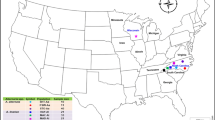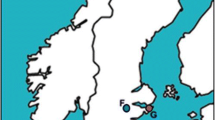Abstract
As causal agent of early blight disease in tomato and potato, Alternaria solani is an internationally important horticultural pathogen. Genetic variability was surveyed by amplified fragment length polymorphism analysis in a total of 112 isolates from potato and tomato, representing pathogen populations from different Cuban provinces together with isolates from the USA, Brazil, Turkey, Greece and China. Also included in the analysis were isolates from catenulated Alternaria spp. from Brazil, Canada, Greece and Russia, along with single isolates of Alternaria porri, Alternaria alternata and a Curvularia sp. UPGMA clustering revealed a differentiation between the isolates of A. solani and all other species with the exception of A. porri which could not be distinguished from A. solani. Among the isolates of A. solani, two distinct subclusters were formed, with high genetic significance revealed by bootstrapping, corresponding to a general subdivision based on the respective solanaceous host. The results are discussed with regard to potential host specificity of A. solani on tomato and potato, and in terms of the comparative contributions of regional and international genetic variability in populations of this ubiquitous plant pathogen.
Similar content being viewed by others
References
Adachi Y, Watanabe H and Tsuge T (1996) Relationships between genetic polymorphisms and fungicide resistance within Alternaria alternata. Phytopathology 86: 1248–1254.
Akamatsu H, Taga M, Kodama M, Johnson M, Otani R and Kohmoto K (1999) Molecular karyotypes for Alternaria plant pathogens known to produce host-specific toxins. Current Genetics 35: 647–656.
Andersen B, Kroger E and Roberts RG (2001) Chemical and morphological segregation of Alternaria alternata, A. gaisen and A. longipes. Mycological Research 105: 291–299.
Aradhya MK, Chan HM and Parfitt DE (2001) Genetic variability in the pistachio late blight fungus, Alternaria alternata. Mycological Research 105: 300–306.
Bock CH, Thrall PH, Brubaker CL and Burdon JJ (2002) Detection of genetic variation in Alternaria brassicicola using AFLP fingerprinting. Mycological Research 106: 428–434.
Bonde R (1929) Physiological strains of Alternaria solani. Phytopathology 19: 533–548.
Bruner SC (1918) La pudrición del tomate y modo de evitarla. Revista de Agricultura, Comercio y Trabajo 1: 300–303.
Ellis JB and Martin GB (1882) New species of North American fungi: Macrosporium solani. American Naturalist 16: 1001–1004.
Ellis MB (1971) Dematiaceous Hyphomycetes. Commonwealth Mycological Institute, FAO, Kew, Surrey.
Esquivel EA (1984) Pleospora solani sp-nov, telemorphosis of Alternaria solani (Ell and Mart) Jones and Grout. Phytopathology 74: 1014.
Excoffier L, Smouse PE and Quattro JM (1992) Analysis of molecular variance inferred from metric distance among DNA haplotypes: Application to human mitochondrial DNA restriction data. Genetics 131: 479–491.
Franco J, Crossa J, Ribaut JM, Betran J, Warburton ML and Khairallah M (2001) A method for combining molecular markers and phenotypic attributes for classifying plant genotypes. Theoretical and Applied Genetics 103: 944–952.
Gordon TR and Martyn RD (1997) The evolutionary biology of Fusarium oxysporum. Annual Reviews of Phytopathology 35: 111–128.
Izquierdo F (1981) Evidencia de la existencia de razas fisiológicas en Alternaria solani. Revista de Ciencias Biológicas 12: 223–233.
Martínez B, Bernal A, Pérez S and Munis Y (2002) Variabilidad patogénica de aislamientos en Alternaria solani Sor. Revista de Proteccion Vegetal 17: 45–53.
McDonald BA (1997) The population genetics of fungi: Tools and techniques. Phytopathology 87: 448–453.
Morris PF, Connolly MS and St Clair DA (2000) Genetic diversity of Alternaria alternata isolated from tomato in California assessed using RAPDs. Mycological Research 104: 286–292.
Mukherji S (1961) Untersuchungen zur Änderung der Pathogenität von Alternaria porri (Ell.) Saw. f. sp. solani E. et M. Journal of Phytopathology 41: 317–352.
Neergaard P (1945) Danish Species of Alternaria and Stemphylium. Taxonomy, Parasitism, Economical Significance. Humphrey Millford, Oxford University Press, London.
Peever TL, Olsen L, Ibañes A and Timmer LW (1999) Genetic differentiation and host specificity among populations of Alternaria spp. causing brown spot of Grapefruit and Tangarina × Grapefruit hybrids in Florida. Phytopathology 90: 407–414.
Pei MH and Ruiz C (2000) AFLP evidence of the distinctive patterns of life-cycle in two forms of Melampsora rust on Salix viminalis. Mycological Research 104: 937–942.
Petrunak DM and Christ BJ (1992) Isozyme variability in Alternaria solani and Alternaria alternata. Phytopathology 82: 1343–1347.
Pryor BM and Gilbertson RL (2000) Molecular phylogenetic relationships amongst Alternaria species and related fungi based upon analysis of nuclear ITS and mt SSU rDNA sequences. Mycological Research 104: 1312–1321.
Roberts RG, Reymond ST and Andersen B (2000) RAPD fragment pattern analysis and morphological segregation of smallspored Alternaria species and species groups. Mycological Research 104: 151–160.
Rotem J (1966) Variability in Alternaria porri f.sp. solani. Israel Journal of Botany 15: 48–57.
Rotem J (1994) The Genus Alternaria: Biology, Epidemiology and Pathogenicity. APS Press, St. Paul, Minnesota.
Salamiah A, Akamatsu H, Fukumasa-Nakai H, Otani H and Kodama M (2001) Construction and genetic analysis of hybrid strains between apple and tomato pathotypes of Alternaria alternata by protoplast fusion. Journal of General Plant Pathology 67: 97–105.
Sambrook J, Fritsh EF and Maniatis T (1989) Molecular Cloning: A Laboratory Manual. Cold Spring Laboratory Press, New York.
Sharma TRT and Tewari JP (1998) RAPD analysis of three Alternaria species pathogenic to crucifers. Mycological Research 102: 807–814.
Simmons EG (1992) Alternaria taxonomy: Currents status, viewpoint, challenge. In: Chelkowski J and Visconti A (eds) Alternaria: Biology, Plant Diseases and Metabolites. Elsevier Science Publishers, Amsterdam, pp. 1–35.
Simmons EG (2000) Alternaria themes and variations (244-286), species on solanaceae. Mycotaxon, LXXV: 1–115.
Stancheva Y (1989) Investigations of the phytotoxic activity of culture filtrates of different isolates of Alternaria solani. Rasteniev'dni-Nauki 26: 97–101.
Tsuge T, Hayashi N and Nishimura S (1987) Selection of auxotrophic mutants and heterokaryosis in Alternaria alternata. Annals of the Phytopathological Society of Japan 53: 182–190.
Vos P, Hogers R, Bleeker M, Reijans M, van de Lee T, Hornes M, Frijters A, Pot J, Peleman J and Kuiper M (1995) AFLP: A new technique for DNA fingerprinting. Nucleic Acids and Research 23: 4407–4414.
Weir TL, Huff DR, Christ BJ and Romaine CP (1998) RAPD-PCR analysis of genetic variation among isolates of Alternaria solani and Alternaria alternata from potato and tomato. Mycologia 90: 813–821.
Yap IV and Nelson RJ (1996) WinBoot: A program for performing bootstrap analysis of binary data to determine the confidence limits of UPGMA-based dendrograms. IRRI Discussion Paper Series No. 14, International Rice Research Institute, Manila.
Author information
Authors and Affiliations
Corresponding author
Rights and permissions
About this article
Cite this article
Pérez Martínez, S., Snowdon, R. & Pons-Kühnemann, J. Variability of Cuban and International Populations of Alternaria solani from Different Hosts and Localities: AFLP Genetic Analysis. European Journal of Plant Pathology 110, 399–409 (2004). https://doi.org/10.1023/B:EJPP.0000021071.65146.c0
Issue Date:
DOI: https://doi.org/10.1023/B:EJPP.0000021071.65146.c0




